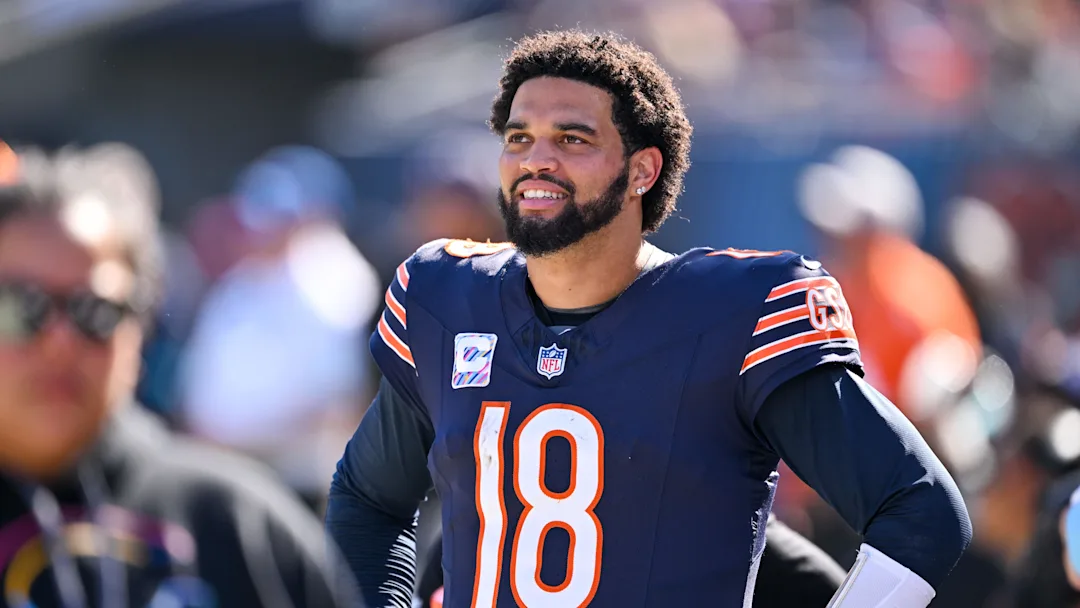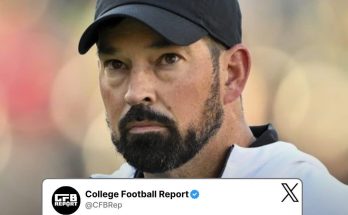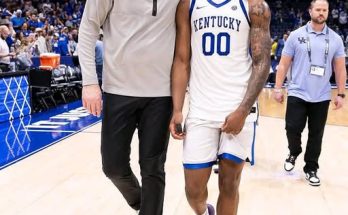In the ever-evolving world of football, few topics spark as much debate and interest as the emergence of new quarterback talents. Each generation witnesses the rise of gifted young athletes who bring a unique blend of skills, leadership, and charisma to the game. One such player who has captured the attention of fans, analysts, and even NFL veterans alike is Caleb Williams, the dynamic quarterback who has taken college football by storm. Recently, an esteemed NFL veteran made an eye-opening comparison between Williams and a legendary quarterback, offering a fascinating perspective on the young phenom’s potential and style.
Caleb Williams has been nothing short of a revelation. Since his arrival on the college scene, his ability to make plays both inside and outside the pocket, combined with his sharp football IQ, has set him apart from many of his peers. His arm talent is exceptional, but what truly makes him stand out is his poise under pressure and uncanny ability to improvise. This has drawn parallels to some of the all-time greats in the position, but few comparisons carry the weight of a direct endorsement from an NFL veteran who has excelled at the highest level.
The veteran in question is none other than Joe Montana, a name synonymous with quarterback greatness. Montana’s career with the San Francisco 49ers is the stuff of legend—four Super Bowl titles, three Super Bowl MVPs, and a reputation for clutch performances when it mattered most. When Montana weighs in on a young player, football fans listen intently. His recent comments comparing Caleb Williams to himself stunned many and provided valuable insight into what makes Williams so special.
Montana highlighted Williams’ combination of natural athleticism, mental toughness, and leadership—qualities that Montana himself embodied throughout his career. “When I watch Caleb play, I see a quarterback who has that rare ability to stay calm in chaotic situations and find a way to win,” Montana said in a recent interview. “He’s not just a great arm or a fast runner; he’s a cerebral player who understands the game at a deep level. That’s what separates good quarterbacks from great ones.”
What makes Montana’s comparison particularly striking is how it bridges the gap between eras. Football has evolved considerably since Montana’s heyday, with new offensive schemes, rules, and athletic benchmarks. Yet, Montana sees in Williams the timeless traits that define true greatness at the quarterback position. “The game changes, but the fundamentals remain the same,” Montana explained. “Caleb reminds me a lot of myself in how he approaches the game—always prepared, always looking to make the right play, and always leading his team with confidence.”
Williams’ journey to this point has been marked by perseverance and continuous improvement. Coming out of high school, he was regarded as a top recruit, but not everyone immediately foresaw the rapid rise he would have. His time in college has seen moments of brilliance punctuated by intense scrutiny—common for any quarterback with national attention. Yet, Williams has consistently risen to the occasion, showcasing a maturity beyond his years. His ability to read defenses and adjust plays at the line of scrimmage reflects the kind of football IQ that Montana praised.
Moreover, Williams’ leadership qualities have drawn comparisons not only to Montana but also to other iconic quarterbacks such as Tom Brady and Peyton Manning. These players shared a unique capacity to inspire their teammates and elevate the entire offense. Williams’ teammates and coaches have often spoken about his infectious confidence and how he demands excellence from everyone around him. Montana emphasized this as a key ingredient in Williams’ formula for success. “Quarterbacks are leaders first and foremost,” Montana noted. “They set the tone for the entire team. Caleb does that naturally, and it’s something you can’t teach.”
The parallels between Williams and Montana don’t stop at leadership and mental toughness. On the field, their playing styles share certain similarities, even if the eras they play in differ drastically. Montana was known for his quick release and accuracy, traits that Williams has shown flashes of despite being more known for his athleticism. The ability to extend plays with his legs while maintaining pinpoint accuracy downfield is what makes Williams such a threat. Montana acknowledged this dual-threat capability but stressed that it’s the quarterback’s decision-making that ultimately determines success.
“In my day, scrambling was more of a last resort,” Montana reflected. “With Caleb, you see a blend of athleticism and precision. He knows when to keep his eyes downfield and when to take off. That balance is what makes him hard to defend.” This insight highlights a crucial aspect of Williams’ game: his ability to blend traditional pocket passing with modern mobility. It’s a style that has become increasingly valuable in today’s NFL, where defenses must prepare for quarterbacks who can hurt them with both arm and legs.
Montana’s endorsement also carries weight because of his understanding of what it takes to succeed at the professional level. The transition from college to the NFL is notoriously difficult, especially for quarterbacks who must adjust to faster defenders, more complex defenses, and heightened pressure. Montana believes Williams possesses the traits that will help him make that leap successfully. “There’s no question Caleb has the talent,” Montana said. “But what sets him apart is his work ethic and his willingness to learn. That mindset is critical when you get to the next level.”
The NFL veteran’s confidence in Williams is echoed by several scouts and analysts who project him as a top pick in the upcoming NFL Draft. Many point to his physical tools, such as arm strength and mobility, but also emphasize his intangible qualities—leadership, resilience, and football IQ—that Montana highlighted. It’s rare to find a quarterback who embodies all these traits so early in his career.
However, Montana also tempered expectations by reminding fans and analysts that greatness is a journey, not a destination. “I don’t want anyone to think Caleb is already Joe Montana,” he said with a laugh. “He’s still growing, still learning. But if he continues on this path, I believe he can reach that level of excellence.” This humility and recognition of the challenges ahead add a layer of credibility to Montana’s praise. It shows that the comparison is not about hype but about genuine belief in Williams’ potential.
The comparison also opens up broader conversations about the evolution of the quarterback position. Montana’s era was defined by pocket passers who relied heavily on timing and precision. Today’s quarterbacks are often expected to be more versatile, with mobility and improvisation playing a larger role. Williams represents this new breed of quarterback who can blend classic skills with modern athleticism, making him a prototype for the future.
This blending of old-school fundamentals with new-school versatility is what makes Caleb Williams such an intriguing prospect. NFL teams are always searching for quarterbacks who can adapt and thrive in various offensive systems. Williams’ skill set suggests he can fit into multiple schemes, whether it’s a West Coast offense, a spread system, or a more traditional pro-style attack. Montana’s comparison underscores that the best quarterbacks transcend systems—they bring their own style while mastering the core elements of the position.
Fans across the nation have responded enthusiastically to Montana’s comments. Social media platforms exploded with discussions comparing Williams’ highlights to some of Montana’s iconic moments. Some fans noted the similarities in their calm demeanor during crunch time, while others marveled at Williams’ ability to extend plays under pressure, a hallmark of Montana’s own clutch performances. The conversation has reignited excitement around Williams’ career and the possibilities that lie ahead.
In addition to Montana’s praise, other NFL legends and coaches have weighed in on Williams’ potential. The consensus seems to be that while the young quarterback still has areas to refine—such as decision-making under extreme pressure and reading complex defensive coverages—his ceiling is exceptionally high. Montana’s comparison adds a powerful voice to this narrative, giving Williams’ journey a compelling sense of legitimacy.
The discussion also raises important questions about how we evaluate quarterback greatness. Is it purely statistical? Is it championships? Or is it something more intangible—leadership, resilience, and the ability to elevate teammates? Montana’s reflections suggest the latter, emphasizing the holistic nature of quarterback evaluation. Caleb Williams appears to possess all these dimensions, making him not only a potential NFL star but a possible franchise cornerstone.
As the college season progresses and Williams continues to develop, all eyes will remain on him. The weight of Montana’s comparison is both a compliment and a challenge—a reminder that greatness is measured not just by talent but by the relentless pursuit of improvement. For Williams, the path ahead is filled with opportunities and obstacles alike. His ability to navigate this journey will determine if he can truly live up to the lofty expectations set by one of football’s greatest legends.
In the end, the NFL veteran’s eye-opening comparison between Caleb Williams and Joe Montana does more than just draw parallels. It shines a spotlight on a young quarterback poised to leave a lasting mark on the sport. Whether Williams will reach the legendary status of Montana remains to be seen, but one thing is clear: the future of football’s most demanding position looks incredibly bright with Caleb Williams leading the charge.



